New to link building and still feeling a little uneasy about dofollow and nofollow links? Well, it’s about time to get clued in!
Both dofollow and nofollow links in SEO have been around for quite a while. The concept of dofollow links began with Google's Page Rank algorithm in 1998, which aimed to enhance user experience by prioritizing “reliable” webpages based on the frequency of their citations.
In 2005, to tackle comment spam, nofollow links were introduced requiring "no-follow attribute" to be added to the link HTML code in order to stop giving credit to low-quality websites.
Therefore, current dofollow links stand for endorsements from one site to another in order to improve the linked page's ranking, while nofollow links signal search engines not to pass on any authority or ranking credit to the linked page.
In 2025, amid ongoing debates about the impact of dofollow and nofollow links on rankings, one thing remains clear: both are crucial components of a strong backlink profile, each bringing unique value to an effective link building strategy.
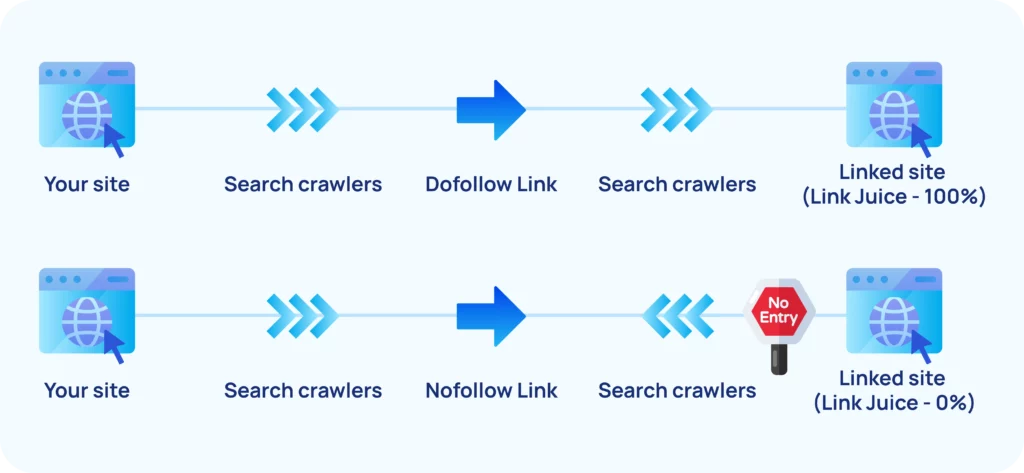
To illustrate the diverse perspectives on this topic, take a look at some common opinions on both dofollow and nofollow links within the SEO community.
- 46.9% of surveyed specialists make an effort to get nofollow links
- 89.1% of link builders think that nofollow links actually make a difference in search rankings.
- About 54% of SEO pros find value in including nofollow links in their backlink profiles.
What Is A Dofollow Link?
A dofollow link is a standard link without attributes. In other words, it doesn't carry any extra directives for search engines but simply passes authority and value (a.k.a. ‘link juice’) to the linked source.
Here’s an example of a dofollow link from a blog post by Ahrefs.

Take a look at the HTML code!
<a href="https://ahrefs.com/blog/seo-metrics-to-track/">important SEO metrics</a>
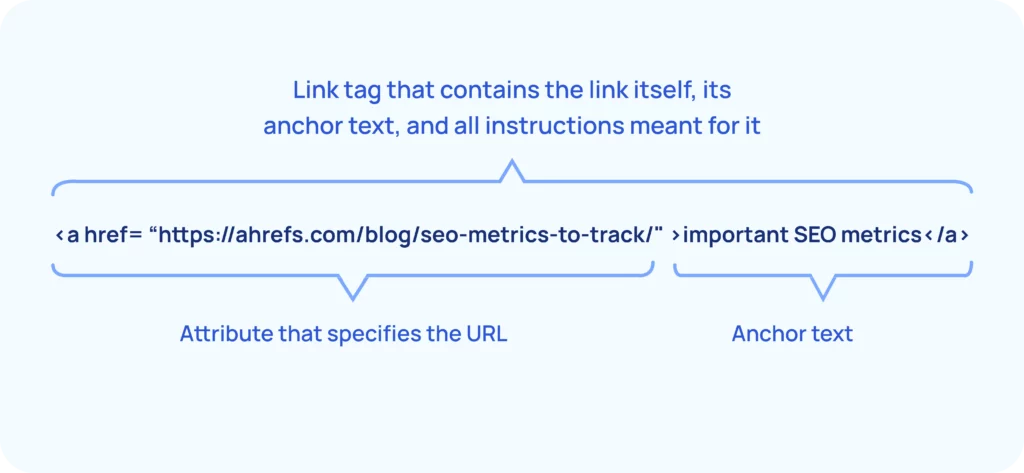
- <a href="https://ahrefs.com/blog/seo-metrics-to-track/: Specifies the destination URL of the hyperlink. In this case, it points to “https://ahrefs.com/blog/seo-metrics-to-track/”, indicating that when the user clicks on the link, they will be taken to the webpage located at that URL.
- "important SEO metrics": It is the visible part of the link that users see on the webpage. When rendered in a web browser, this text will be clickable, and clicking on it will navigate the user to the URL specified in the href attribute.
⚠️ Notice there's no "rel='dofollow'" in the code because it's the default setting and is rated by search engines as a ¨vote of trust¨.
This indicates that we've stumbled upon a standard link, without any extra attributes in the code. It'll just serve as a signal of authority for the page it's pointing to.
Why everyone's chasing dofollow links?
Dofollow links indeed have turned into quite a fad within link builders lately. The more you gather, the better! And it's not just about the user experience and referral traffic that high-quality resources offer. It’s also about the amount of SEO juice dofollow links can drip.
Whenever authoritative websites link to your content, search engines see it as a vote of confidence, hence you can stay on the safe side with constant Google updates, improve rankings, and solidify your online presence all at once!
What Is A Nofollow Link?
A nofollow link is a non-regular link with a special “no follow” attribute in its code, hinting search engines to either ignore or not to crawl nofollowed links.
So, why go for such links? Well, there could be times when you're hesitant to pass authority to a particular webpage you're linking to. In other words, you might prefer not to endorse it.
Plus, as we mentioned before, back in the day nofollow links came to combat spam in comment sections and crackdown on black hatters flooding online resources with their links. For this very reason, in 2005 “no follow” was a real DIRECTIVE to search engines to ignore such links.
But things got less rigid in 2019 when Google introduced a couple of extra ‘no follow’ attributes such as rel=”ugc” for user-generated content and rel=”sponsored” for sponsored content. Since then, both attributes morphed into mere RECOMMENDATIONS or clues for search engines. In other words,nofollow links began to be crawled and incorporated into rankings.
Let's take a look at a common example of a nofollow link, often found when mentioning niche experts in relevant articles.
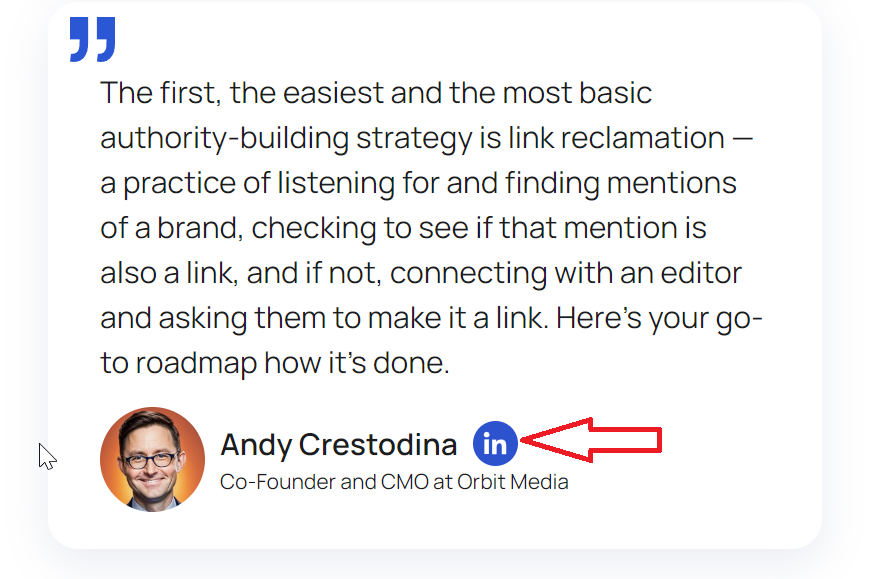
And, here’s the code
<a rel="nofollow" target="_blank" class="qb__social qb__social-linkedin" href="https://www.linkedin.com/in/andycrestodina/"
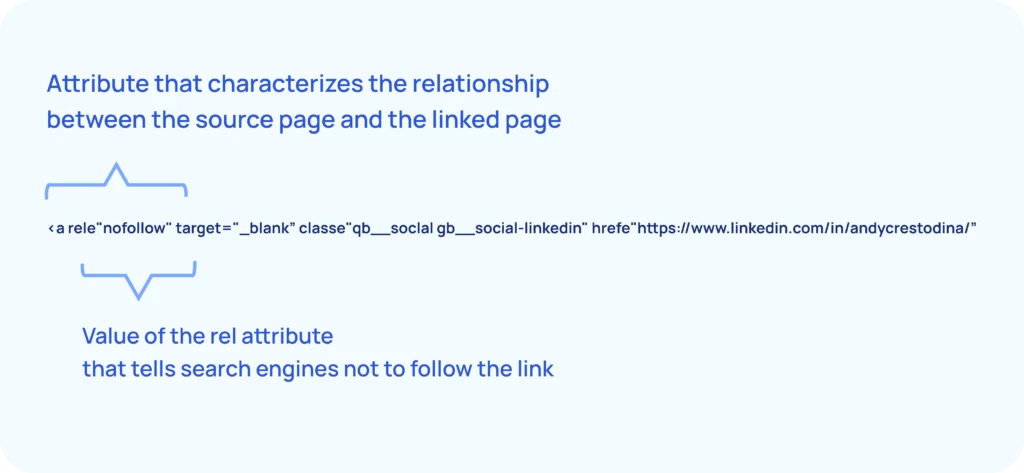
As you may see, the "nofollow" attribute advises search engines not to follow the link, thereby not impacting the ranking of the linked page in search results. However, it still directs users to the LinkedIn profile of the linked individual.
Difference Between Dofollow and Nofollow Links
While you may already have grasped the essentials of dofollow and nofollow links, the key point to remember is this: nofollow links don't pass any link authority while dofollow links are the ones that carry weight. But is this completely accurate?
From Google’s explanation of nofollows we can infer that boundaries can be a little blurred: “In general, we don’t follow them. This means that Google does not transfer PageRank or anchor text across these links”
This vagueness leads to some conspiracy theories, like the idea that nofollow links still pass on some authority or that Google only counts certain nofollow links, but not all of them.
A study by Ahrefs delved into this uncertainty by examining whether there was any correlation between Google rankings and different backlink attributes, including the quantity of followed backlinks.
It turns out that Google DOES consider nofollow backlinks from high-authority sites; however, their impact is just not as strong as that of dofollow links.
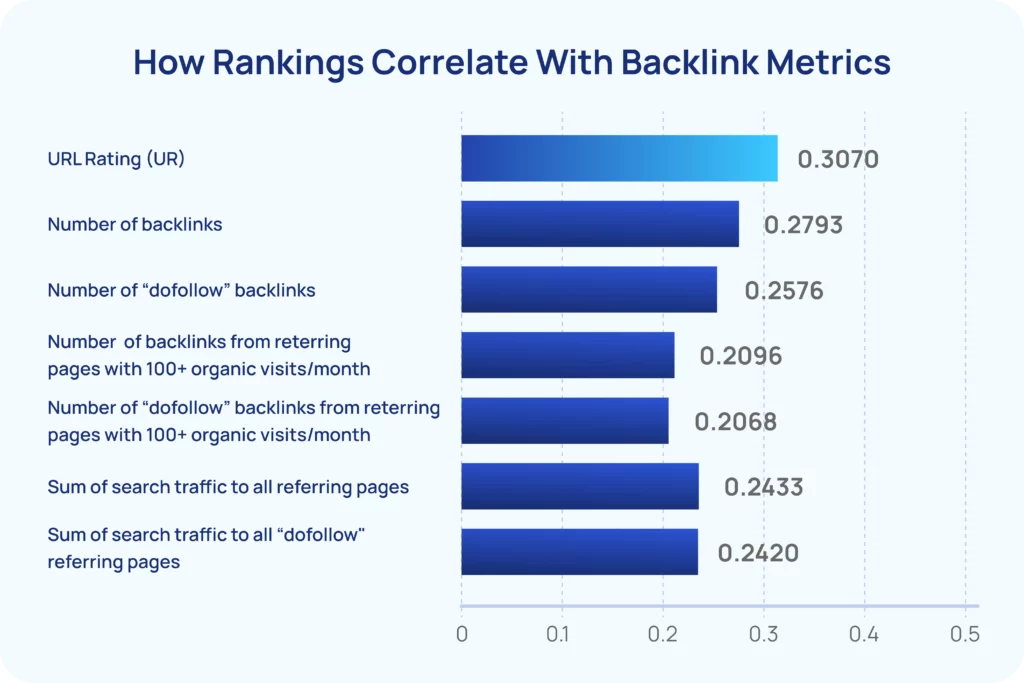
Armed with this alternative perspective, we might reconsider the strict assertion that "if you've accumulated numerous nofollow links, they're unlikely to improve your search rankings."
Instead, we could suggest that "if numerous nofollow links come from reputable websites, they could still contribute to improved rankings in some way." It's better than nothing, isn't it?
On the flip side, dofollow links continue to be crucial for enhancing website visibility and credibility, just as they've always been.
⚠️ Attention! As much as dofollows are wanted and hunted, if you start getting loads of dofollow links from shady and spammy websites, Google will consider yours as the same and downrank it.
Hence, don’t rush to become a partisan of dofollow links ONLY. Nofollow links can also be quite handy for your content strategy too. While they don't boost SEO directly, they're great for driving traffic, increasing brand awareness, and catching the eye of different audiences.
Last but not least, having lots of nofollow links can also show search engines that you're active online, which might add value to your community engagement.
Anyway, here’s more to what differs dofollow and nofollow links.
Nofollow vs Dofollow Links: What’s the Difference?
| Category | Dofollow Links | Nofollow Links |
| Link Juice | Pass authority and contribute to ranking | Do not pass authority or link juice |
| Crawlability | Search engines follow and crawl the link | Search engines do not follow the link |
| Indexing | Linked page is typically indexed | Linked page may or may not be indexed |
| Anchor Text | Contribute to anchor text relevance | Do not contribute significantly to anchor text relevance |
| Spam Mitigation | May attract spam if not monitored closely | Often used to mitigate spam and maintain link quality |
| User Engagement | May encourage more user interaction | Less likely to encourage user interaction |
| Traffic Generation | Can drive organic traffic to the linked page | Can still generate traffic, but typically less effective than dofollow links |
| SEO Impact | Directly impact search engine rankings | Indirectly influence SEO by driving traffic and enhancing website reputation |
| Trustworthiness | Often associated with credible and authoritative sources | May be associated with user-generated content and less trustworthy sources |
Are Nofollow Links Bad for SEO?
Definitely not!
If a link is a nofollow and generates referral traffic to your website, would you consider it a bad link? I don’t think so!
While it may seem like nofollow links don't impact your SEO much, there are some goodies you might miss by not using them at all. Take a look!
Steady traffic
Even if nofollow links don't jazz up your backlink profile, they still reel in valuable traffic. When users click and engage with them like any other link, traffic finds its way to your website, endorsing your content and offerings.
At the same time, more traffic on your page can drum up more leads and amp up conversions. And it's a win-win: engaged leads hang around longer on your website, boosting its dwell time. This sends positive signals to Google about your page's relevance, potentially rocketing your rankings in search results.
Stronger brand presence
Another bonus of using nofollow links is that they help spread awareness of your brand, products, and services to larger audiences, again, thanks to increased traffic.
Brand building isn't just a buzzword online; so the more people recognize your presence, the more your business can flourish. And nofollow links can do a great deal of work for you here.
Nofollow links hold untapped potential as a valuable source of traffic, brand recognition, and even further link opportunities. In today’s digital landscape, Google’s algorithm extends beyond mere URLs and links; it evaluates your brand and product as an entity.
This perception is shaped not only by your website but also by how the internet converses about your brand, even in the absence of direct links. In the 2024, being part of conversations is paramount, as the phrases and words associated with your brand play a pivotal role in establishing its brand identity
Organic backlink profile
Google is a skeptical guy, so banking only on dofollow links isn't just unrealistic; it might raise eyebrows, hinting at shady tactics.
A trustworthy, organic backlink profile should include all sorts of links, including nofollow ones from reputable sources. This not only brings your website credibility but quality traffic. And we all know its perks.
Potential dofollow linking
While snagging dofollow links from big sites like the New York Times is notoriously tough, aiming for a nofollow link can still be a win. Why? For the third time: because of the traffic it could bring!
And you never know WHO is in that traffic. Could it be a famous blogger? Or a niche expert? They might want to connect with you and offer a dofollow link down the line. One dofollow link can lead to another, and so on, naturally building your website's authority.
Still sure nofollows as worthless for your SEO? Think again!
How To Check Dofollow and Nofollow Links
Well, there are a few ways to learn how to check dofollow and nofollow links: you can do it manually or use specialized tools. Let's walk through each method step by step.
Inspect links in Chrome browser
When browsing pages in Chrome, you can easily view the link code highlighted by right-clicking on a link anchor and selecting “Inspect”.
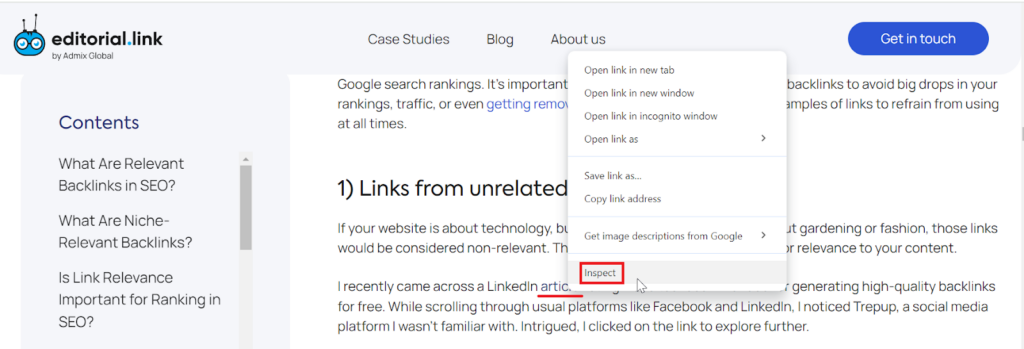
When you click, a new tab will open displaying the page code, including the link code, on the right side of your browser window. Be sure to pay close attention to the link’s attribute. If it’s <a href only and the rel attribute is not there, it’s a 100% dofollow link.
See the example below.

Nofollow link codes would include their typical rel="nofollow" attribute. You can locate them in Chrome using the same method: simply click on "Inspect".
Check out the example.
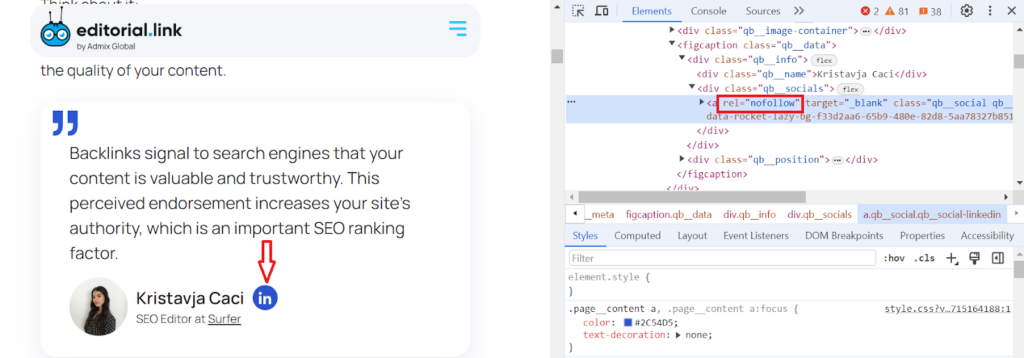
Use browser extensions
There exist numerous browser extensions that can help you spot either dofollow or nofollow external links on a page. If you are big on Chrome, the easiest way is to use its Strike Out Nofollow Links extension.
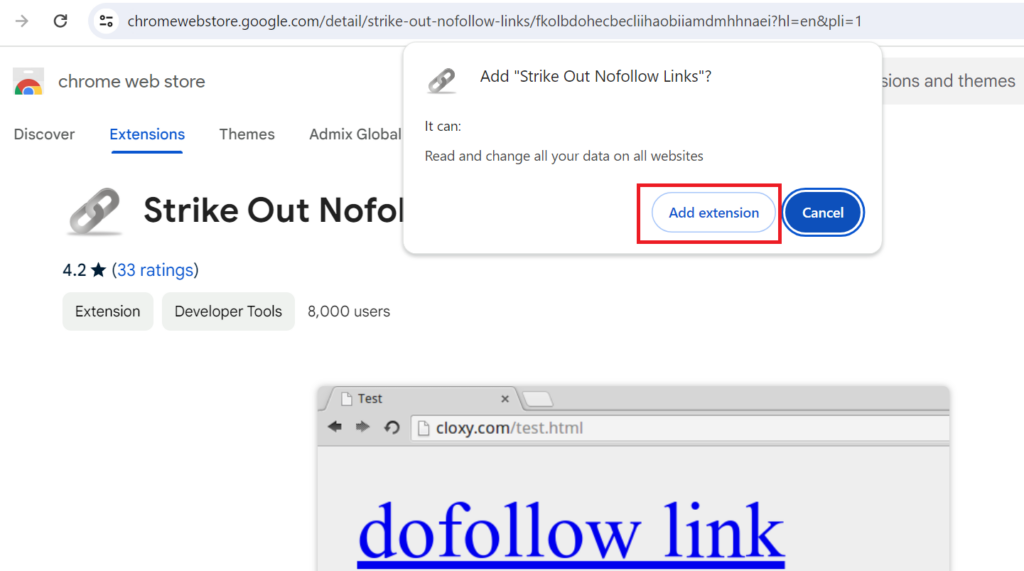
Pin to activate!

Now enjoy automated identification of nofollow links with strikethrough text format, as shown in the example below.
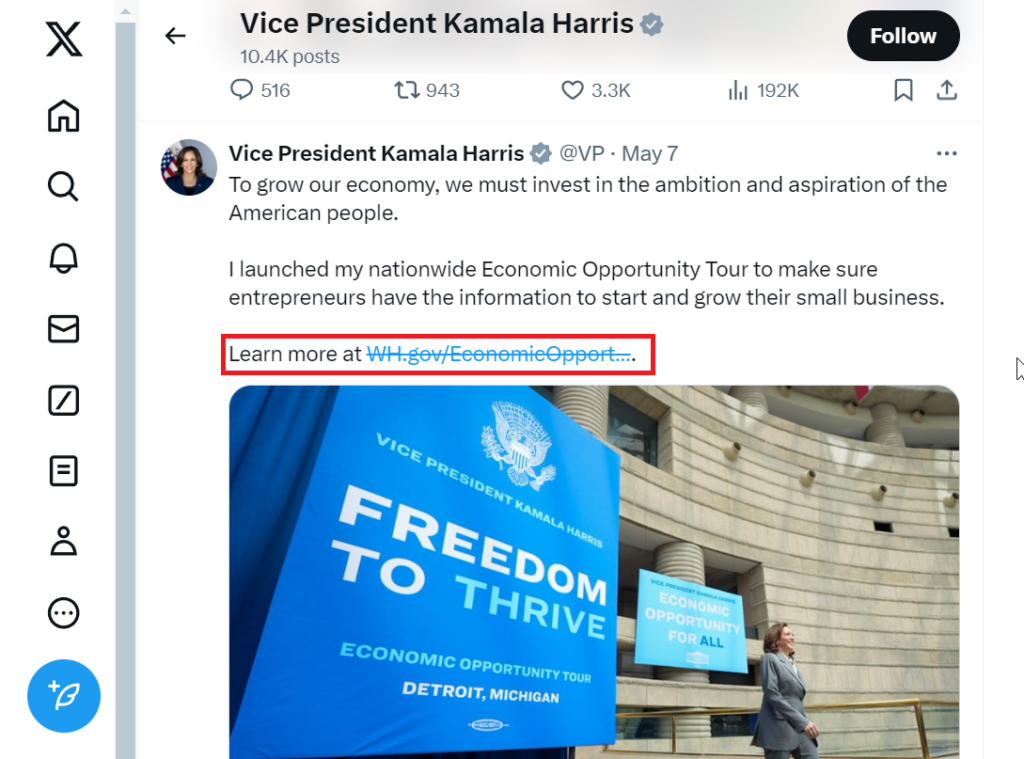
Leverage SEO tools
This method isn't for checking citations on a single page, but rather for reviewing all the links on a chosen website or another domain. You can use any SEO tool you have, like Ahrefs Site Explorer in our very case.
To view a list of both dofollow and nofollow links, we'll input the website URL (using Search Engine Land as an example) into the Site Explorer tab. Then, navigate to Referring Domains and select either the "Dofollow" or "Nofollow filter" to see each respective list of links.

When you click on the dofollow filter, you'll see those links immediately. However, if you select the nofollow filter, you'll find various types available, including "Nofollow" only, "UGC", or "Sponsored".
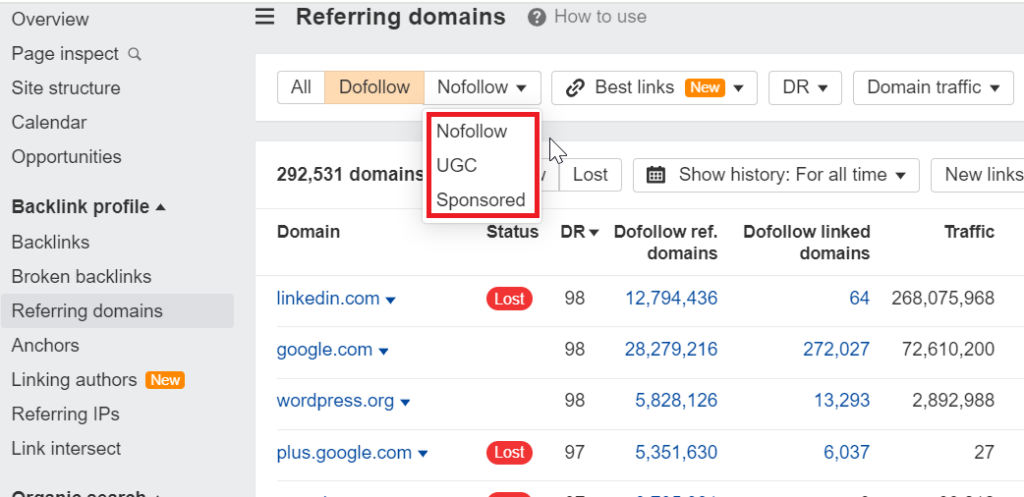
Let's say we want to see the complete list of Sponsored links on Search Engine Land's website. We'll adjust the filter accordingly to display only the Sponsored links. Here you go!
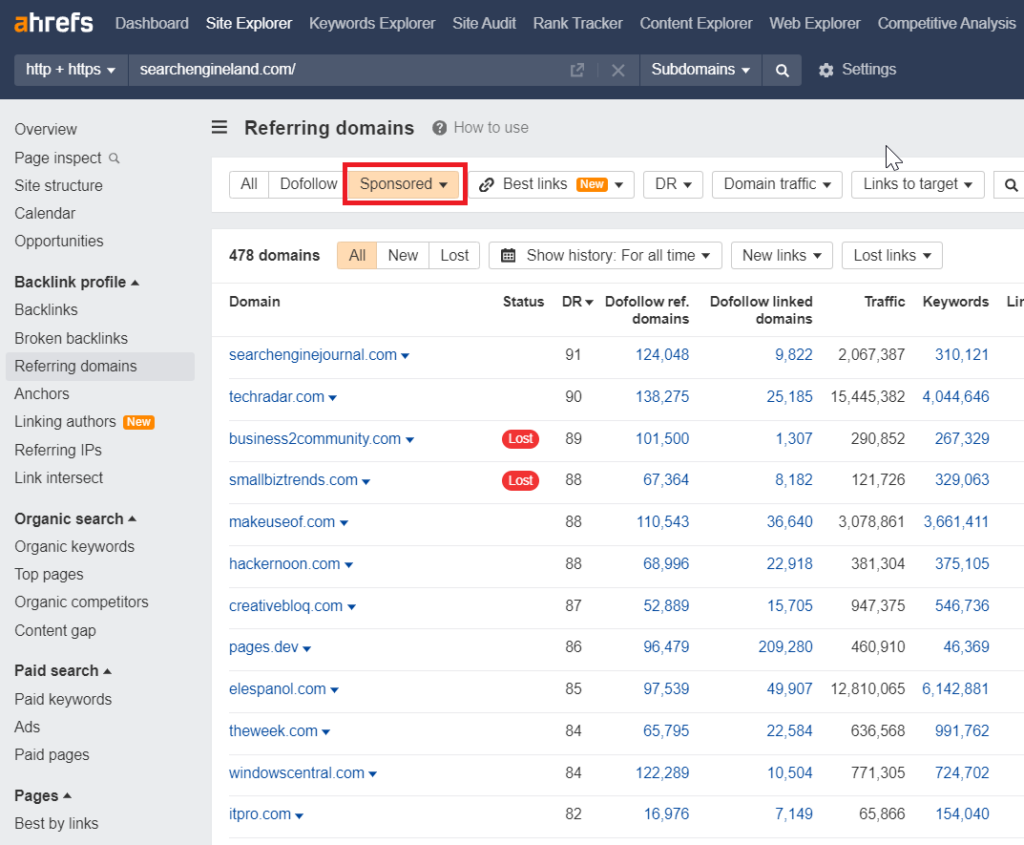
To assess the ratio of dofollow vs nofollow links for any website or webpage using Ahrefs, navigate to the Site Explorer, enter a domain or URL, and click on Overview.
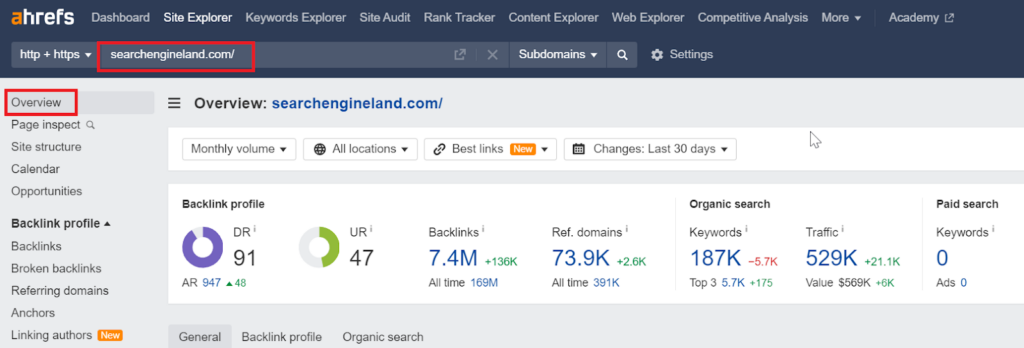
Scroll down to the bottom of the displayed metrics and find the bar chart for referring domains (linking websites). Here, you'll be able to gauge the percentage ratio between followed and nofollowed domains.
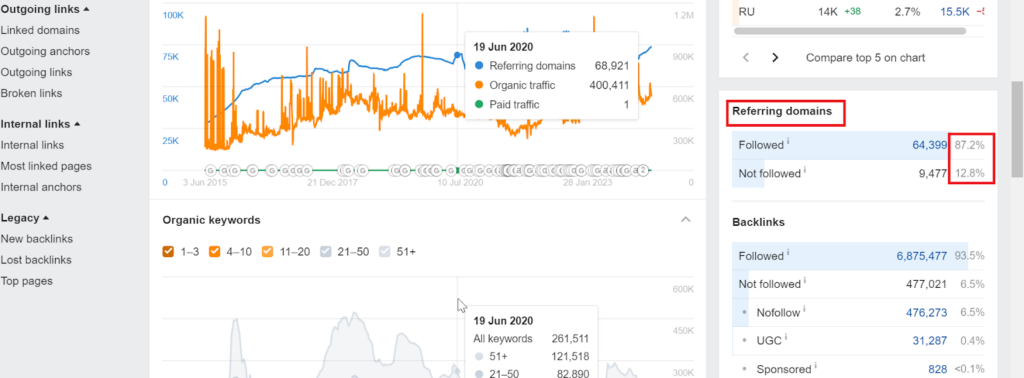
Looks like 82.2% of the referring domains to Search Engine Land are followed, which is pretty organic. Natural metrics typically fall within the same range, around 60% to 90%. If it hits 100%, it's a bit fishy, my fellas, so trust your gut!
How To Use Nofollow and Dofollow Links Together
Considering everything mentioned earlier, the safest and most sensible strategy for all link builders is to aim for both follow and nofollow backlinks, strategically sourcing them from authoritative sources. This way, you’ll be able to make the most even from the nofollow links, as recommended by the Ahrefs study. Plus, you can always rely on additional link building activities to enrich your strategy.
Typically, a healthy backlink profile has 70-90% dofollow links and 10-30% nofollow links. However, aside from Featured and Connectivity (formerly HARO), my link-building strategy mainly relies on viral marketing and linkable assets. This is far more effective for getting a mass of high authority links, dofollow and nofollow.
Nofollow links are also still excellent. I’ve had significant launches using nofollow links, which resulted in press from many blogs (using dofollow links) in my niche. The impact on my organic search traffic was instant
💡Pro-tip! Strive for a balanced link profile with around 60% dofollow and 40% nofollow links on your site. Alternatively, consider a slight variation with 70% dofollow vs 30% nofollow links, making sure nofollow links remain within the 30-40% range.
Additionally, consider the following tips:
Focus on strong sides
Dofollow vs nofollow links sometimes can be seen as two sides of the same coin. While dofollow links certainly boost search rankings, let's not forget the value of nofollow links—they're great for driving traffic, boosting brand visibility, and keeping your link profile looking natural and diverse.
💡Pro-tip! Leverage the strengths of both dofollow and nofollow links to tailor your link building strategy. To do so, keep up your authority strong with dofollow links but additionally back up rankings with increasing traffic from nofollow links.
Smart placement
To make the most of both types of links, focus on their strategic placement. For instance, save your dofollow links for respected sites in your industry. For newer or less authoritative websites, forums, and social media platforms, opt for nofollow links. This way, you diversify your link profile and attract referral traffic in one go.
💡Pro-tip! Sometimes, a couple of nofollow links from top resources like Search Engine Land can bring in more traffic than a dozen follow links from less authoritative sources. So, weigh your options wisely.
When strategizing link placements, prioritize factors such as trustworthiness, audience relevance, and volume over other metrics. Assess whether the source is a trusted entity, if its audience aligns with yours, and then consider the quantity of traffic, as this in itself can lead to more shares, links if the content has virality
Stick to quality
Remember, it's not just about securing as many backlinks as you can; quality reigns supreme. Concentrate on securing links from authoritative sites within your niche. A handful of top-notch dofollow links from trusted sources will wield far more influence on your search rankings than a slew of lower-quality ones.
Harness the potential traffic
As we talked about the traffic potential of nofollow links, it brought to mind another study: Ranking Factors 2.0 by Semrush, which underscores the significant impact of direct website visits on rankings.
However, your traffic isn't solely determined by the authority of the website you place nofollow links on. It also hinges on how engaged visitors are with your content and whether they're inclined to follow an outbound link to your site. So, focus on optimizing this aspect as well.
Nofollow links can do wonders for your traffic, but it’s not because of the link, that’s because of what you do to get the link.
Larger publications often include no-follow links, but that’s fine if they are talking about you positively and showing users how they can engage with you.
We see very strong correlations between the strength of a brand and their ranking position. Brands don’t often care as much about whether a link is do/no follow, they instead focus on how the story was received and used.
Expand your link sources
To build a comprehensive backlink profile, aim for variety. Look for chances to get both dofollow and nofollow links from different platforms like guest blogging, social media, online directories, industry forums, and partnerships with influencers. This mix will not only enrich your link collection but also expose you to diverse audiences.
Tailor your link-building campaign
Now, rewind to how we discussed the ideal ratio of nofollow vs dofollow links. While the latter are inarguably dominant, a successful link building strategy would inevitably involve integrating nofollows into various link-building activities such as:
- Guest blogging: Contribute premium-quality content to reputable industry websites. While some won’t give you dofollow links, many will gladly offer nofollow ones!
- Socials: Share your content on social media platforms, even with nofollow links back to your site. They still boost your visibility, particularly if you're actively engaging in comments and relevant discussions.
- Online communities: While the effectiveness of online forums, Q&A sites, and niche-related community platforms is quite disputable in 2025, it would never hurt to snag some referral traffic from such platforms as Reddit or Quora. Relying solely on these may not be wise. Instead, use them as an occasional alternative for acquiring nofollow links.
- PR link building: Again, banking on press releases in 2025 might seem too obsolete, but leveraging public relations links coming from media outlets, newspapers, or journalists is totally okay as long as these are authoritative and reputable.
- Collabs: Partner with influencers, bloggers, businesses, or organizations in your niche. Even if their links are nofollow, the exposure and potential referral traffic are valuable.
Final Thoughts
Even though they're conceptually different, both dofollow and nofollow links serve the same purpose: they boost website authority, grow traffic, brand recognition, and visibility. Hence, considering nofollow links ineffective in 2025 is just obsolete. In reality, both types of links work together to create a solid and effective link building strategy.
To really make it work, it's essential to maintain the proper balance between using dofollow and nofollow links. Here at Editorial.Link, we excel in strategically placing both dofollow and nofollow links in just the right mix to craft an organic backlink profile that gets noticed by Google.
Let's connect and boost your digital presence the way you want it to be.





